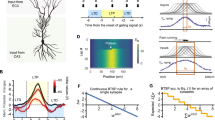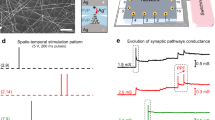Abstract
BIOLOGICAL theories of memory formation have relied heavily on the idea that the use of a pathway in the brain can bring about changes that facilitate transmission along the same pathway in the future1. The converse, that memory consists of the elimination of alternative routes, may seem at first less appealing, but the idea of learning as a suppression of unwanted responses is familiar at the behavioural level2. This report is about a theory of memory based on the suppression or weakening of synaptic transmission in unused pathways. It draws on recent experiments on the regeneration of neurornuseular synapses in fish for evidence that an appropriate mechanism may exist.
This is a preview of subscription content, access via your institution
Access options
Subscribe to this journal
Receive 51 print issues and online access
$199.00 per year
only $3.90 per issue
Buy this article
- Purchase on SpringerLink
- Instant access to full article PDF
Prices may be subject to local taxes which are calculated during checkout
Similar content being viewed by others
References
Grossman, S. P., A Textbook of Physiological Psychology (Wiley, New York, 1967); Burke, W., Nature, 210, 269 (1966); Griffith, J. S., ibid., 211, 1160 (1966); Brindley, G. S., Proc. Roy. Soc., B, 168, 361 (1967); Griffith, J. S., and Mahler, H. R., Nature, 223, 580 (1969); Gardner-Medwin, A. R., ibid., 223, 916 (1969).
Young, J. Z., The Memory System of the Brain (Oxford University Press, London, 1966).
Horridge, G. A. Interneurons (W. H. Freeman, London, 1968).
Sperry, R. W., J. Comp. Neurol., 79, 33 (1943); J. Neurophysiol., 7, 57 (1944); Physiol. Zool., 21, 351 (1948); Maturana, H. R., Lettvin, J. Y., McCulloch, W. S., and Pitts, W. H., Science, 103, 1409 (1959); Gaze, R. M., Intern. Rev. Neurobiol., 2, 1 (1960).
Attardi, D. G., and Sperry, R. W., Exp. Neurol., 7, 46 (1963).
Sperry, R. W., Proc. US Nat. Acad. Sci., 50, 703 (1963).
Gaze, R. M., and Jacobson, M., Proc. Roy. Soc., B, 157, 420 (1963); Cronly-Dillon, J. R., J. Neurophysiol., 31, 410 (1968).
Wiesel, T. N., and Hubel, D. H., J. Neurophysiol., 28, 1029 (1965); Hubel, D. H., and Wiesel, T. N., ibid., 28, 1041 (1965); Wiesel, T. N., and Hubel, D. H., ibid., 28, 1060 (1965).
Mark, R. F., von Campenhausen, G., and Lischinsky, D. J., Exp. Neurol., 16, 438 (1966).
Mark, R. F., Exp. Neurol., 12, 292 (1965); Brain Res., 14, 245 (1969).
Sperry, R. W., and Arora, H. L., J. Embryol. Exp. Morphol., 14, 307 (1965).
Marotte, L. R., and Mark, R. F., Austral. J. Exp. Biol. Med. Sci., 48, 52 (1969); Brain Res. (in the press).
Marotte, L. R., and Mark, R. F., Brain Res. (in the press).
Roberts, R. B., and Flexner, L. B., Quart. Rev. Biophys., 2, 135 (1969).
McIntyre, A. K., Proc. Symp. on Memory, ANZAAS 41st Conf., Adelaide (1969).
Cragg, B. G., J. Anat., 101, 639 (1967).
Author information
Authors and Affiliations
Rights and permissions
About this article
Cite this article
MARK, R. Chemospecific Synaptic Repression as a Possible Memory Store. Nature 225, 178–179 (1970). https://doi.org/10.1038/225178b0
Received:
Issue date:
DOI: https://doi.org/10.1038/225178b0
This article is cited by
-
Shortcomings of the psychomedical research of John Money and co-workers into sex differences in behavior: Social and political implications
Sex Roles (1982)
-
A new hypothesis for synaptic modification: An interactive process between postsynaptic competition and presynaptic regulation
Biological Cybernetics (1980)
-
Synapses of optic nerve afferents in the rat suprachiasmatic nucleus
Cell and Tissue Research (1978)
-
Competition between Nerves for Functional Connexions with Axolotl Muscles
Nature (1973)



